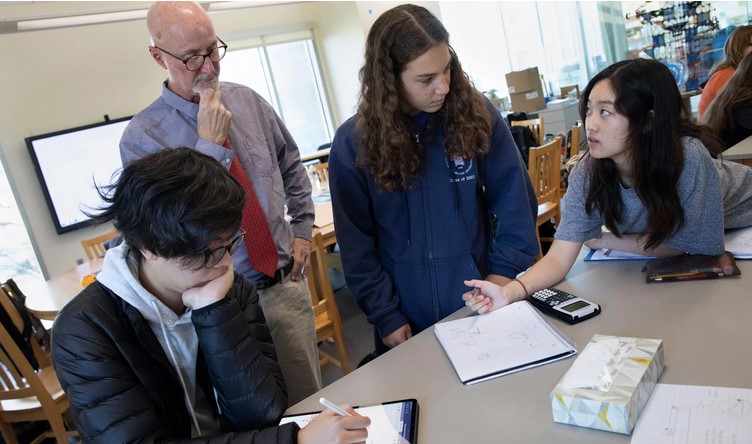3 Tips for Guiding Students to Grow in Math With Error Analysis
Working backward to identify errors in solved math problems encourages students to adopt a growth mindset.
It’s widely acceptable for students and even adults to say, “I’m not good at math.” Far more acceptable than saying, “I’m not good at reading.” I’ve spent countless hours wondering why that is. I’ve come to that somewhere along their educational journey; the math naysayers were not celebrated when they made mistakes in the math classroom.
Making a mistake in front of others is nerve-racking for anyone, especially a student in front of their peers. But it doesn’t have to be! Not if mistake-making is celebrated. We must create brave spaces where students trust that they will not be put down when they take intellectual risks and make mistakes.
We have all been conditioned to believe that getting the right answer to a math problem means that you’re “good at math.” Students who get the right answer are celebrated. We know through research that our brain grows more when we make mistakes than when we correct a problem. Convincing students of this will take time and a fundamental mindset shift.
Students need a growth mindset to see the good in mistakes. Teachers can design lessons that support the belief that mistakes are beautiful and must be celebrated. The strategy most prominent in my math teacher’s classrooms is the use of error analysis.
Using error analysis in the math classroom requires students to work backward. Rather than solving a math problem, students are given a solved problem that contains errors. Students examine the problem, identify any errors made in solving it, justify their reasoning, and solve the problem correctly. These problems often contain conceptual errors and/or computational errors.
3 Ways to Use Error Analysis
1. Error analysis is a great way to generate student discussion. After giving students a traditional math problem, it’s difficult to have a pair or group discussion immediately because students often need to solve the problem independently; I know I do. The following discussions tend to center around the steps they used to find their solution.
With error analysis, a pair or group of students can be given a solved problem and immediately begin discussing what they’ve noticed. They are able to talk about the types of mistakes they identified and why the person solving the problem may have made that mistake. These types of discussions in math truly allow students to understand how problems are solved, and they promote strategic thinking.
2. The placemat strategy is a wonderful vehicle for error analysis. The placemat strategy, often utilized in humanities classes, calls for groups of four students to respond to a given prompt independently. They take turns sharing their responses. The group synthesizes their individual contributions into a final group response that is composed of all members’ initial responses.
Adapting this strategy for math, the prompt is replaced with a completely solved math problem containing a series of computational and/or conceptual errors. Students analyze the problem and identify as many mistakes as they can find. Each group member shares their findings and reasons why they believe an error was made. The group synthesizes their findings and then uses those findings to solve the problem correctly.
Following the placemat activity, one group member is selected to share the group’s process, findings, and solution. By randomly selecting the presenting student, the whole group must take ownership of their work together and be prepared to speak about it. Students who are nervous about presenting are reminded that even if they’re wrong, mistakes are how we learn. Our class norms are to support each other, not ridicule one another.
The placemat strategy also works really well for multiple-choice questions. The question is placed in the middle of the group without the answer choices. Each student is provided one of the answer choices but cannot see their group mates’ answer choices. Individuals must decide if their answer could be correct and justify their reasoning to the group. They must determine whose answer is correct as a team and place that in the middle.
Groups can then present their questions to the class and explain how they determined the correct answer. Using the multiple-choice format, students can practice logical thinking and problem-solving skills that are helpful when answering multiple-choice questions on high-stakes exams.
3. Error analysis works well as a formative assessment. One challenge of error analysis is the time it takes for teachers to create erroneously solved problems. This is where using error analysis as a peer assessment strategy comes in. You can utilize the work completed by your students as your problem set for error analysis.
You give the class a problem to solve independently, and then pairs swap papers and conduct an error analysis of their peers’ responses. Sometimes they will find errors and be able to provide feedback on the mistakes found, but sometimes the problem will be completely correct. In this case, they can articulate how they proved that their peers’ answer was correct.
Following classwork time, you can also review student responses and identify common misconceptions. Then take a photo of a student’s response (without their name) and pose this as an error analysis for your “do now” the next day.
After exams, some teachers allow their students to earn points back through test corrections. Error analysis can be a great strategy for these mastery opportunities. Task students to complete a self-assessment of their own test by analyzing the questions they got wrong, identifying their mistakes, determining why they made that mistakes, and figuring out the correct way to do the problem.
Error analysis in the math classroom reinforces the idea that mistakes are beautiful and that learning from your mistakes is more important than getting the right answer the first time.
Source: https://www.edutopia.org/article/teaching-error-analysis-math-classes




